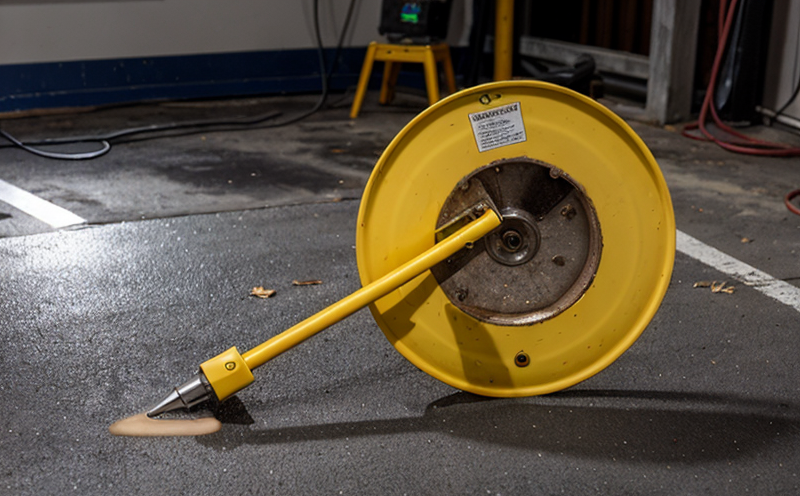ASTM E1310 Eddy Current Testing of Welds
The ASTM E1310 standard provides a comprehensive framework for conducting eddy current testing (ECT) on welds to evaluate their integrity and detect flaws. This method is widely used in sectors such as aerospace, automotive, and manufacturing where the quality and reliability of welded joints are critical. By leveraging eddy currents generated by alternating electromagnetic fields, this non-destructive evaluation technique allows inspectors to assess the surface and subsurface conditions without compromising the integrity of the weld.
ECT is particularly effective for detecting cracks, voids, delaminations, and other defects in ferromagnetic materials like stainless steel, carbon steel, and nickel alloys. The testing process involves passing an alternating current through a coil placed near the surface of the weld to induce eddy currents within the material. Any variations in conductivity or magnetic permeability due to flaws alter these currents, providing insights into the presence and severity of defects.
The ASTM E1310 standard specifies detailed guidelines for test setups, including probe types (e.g., through-holes, multi-segment probes), excitation frequencies, and signal processing techniques. Compliance with this standard ensures consistent and reliable testing results, which are crucial for maintaining quality standards in manufacturing processes.
For accurate ECT of welds, proper specimen preparation is essential. This includes cleaning the surface to remove contaminants that could interfere with signal integrity, ensuring a uniform thickness across the test area, and applying appropriate coupling agents if using direct contact probes. The testing setup should be calibrated regularly to maintain accuracy throughout the inspection process.
Instrumentation plays a pivotal role in ECT, with advanced equipment capable of real-time data acquisition and analysis. Modern systems often incorporate software for automated defect detection, reducing human error and increasing throughput. Reporting typically involves detailed documentation of test parameters, observed defects, and compliance with relevant standards like ASTM E1310.
Understanding the limitations of eddy current testing is important when interpreting results. Factors such as material properties, probe geometry, and excitation frequency can influence signal responses, necessitating careful selection of test parameters for each specific application. Regular calibration and validation ensure that tests meet stringent quality control requirements.
| Standard | Description |
|---|---|
| ASTM E1310-21a | Guidelines for eddy current testing of welds to detect flaws and evaluate their integrity. |
| ISO 9779:1998 | International standard detailing eddy current testing methods for ferromagnetic materials. |
Applied Standards
| Standard | Description |
|---|---|
| ASTM E1310-21a | Provides guidelines for eddy current testing of welds to detect flaws and evaluate their integrity. |
| EN 479:2008 | European standard specifying methods for non-destructive testing of welded joints in pressure vessels. |
| American Society of Mechanical Engineers (ASME) Section V | Details requirements for the design, fabrication, and inspection of nuclear power plant components including welds. |
| Standard | Description |
|---|---|
| American Society of Mechanical Engineers (ASME) Section IX | Regulates the design, construction, and testing of pressure vessels. |
| International Organization for Standardization (ISO) 9779:1998 | Detailed eddy current testing methods for ferromagnetic materials. |
Eurolab Advantages
Eurolab specializes in providing high-precision, reliable ASTM E1310 Eddy Current Testing of Welds services tailored to meet the stringent quality and compliance requirements of various industries. Our team comprises experienced professionals with deep expertise in non-destructive testing techniques.
- Accurate detection of flaws using advanced eddy current probes and software.
- Comprehensive reporting aligned with ASTM E1310 standards for clear communication of test results.
- State-of-the-art calibration facilities ensuring consistent performance across all tests.
- Detailed training programs to upskill clients in the latest testing methodologies and best practices.
We offer a range of services including initial assessments, ongoing monitoring, and troubleshooting support. Our comprehensive approach ensures that our clients achieve regulatory compliance while enhancing product reliability and safety.
Environmental and Sustainability Contributions
- Reduces waste by avoiding destructive testing methods that require sample destruction.
- Contributes to energy efficiency through reduced material usage during manufacturing processes.
- Promotes recycling of materials by ensuring high-quality products are produced without compromising environmental standards.
- Supports sustainable development goals by maintaining product integrity and reducing the need for rework or replacement due to defects.
Eddy current testing helps minimize resource consumption while enhancing industrial processes, thereby supporting broader sustainability initiatives.





